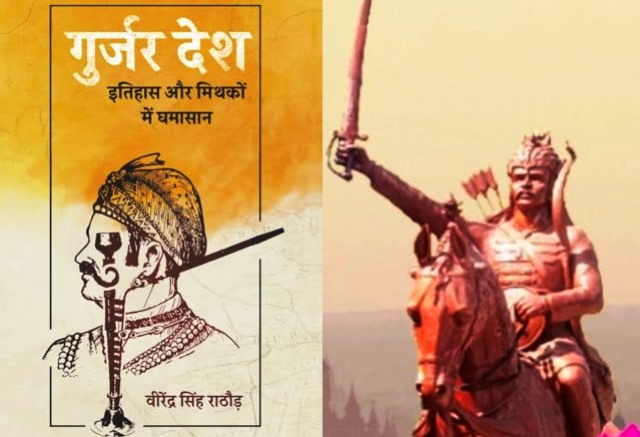
Gurjar Pratihar Debate: Separating the Grain from the Chaff
In this era of identity politics, history has become the social capital on which almost all the communities are claiming their right & have, consequently, got entangled in a culture war, trying to find & assert their respective place. In the times of Post Truth, we often come across the practice of rewriting history. This rewriting of history is aimed at creating new heroes and at re-assigning new identity to historical characters as per vested motivations & conveniences of parties involved.
It is in this context that the debate on the caste identity of the Gurjar (Pratihar) empire has arisen, which soon took the form of ‘Kshatriya versus Gujjar conflict’. Gurjardesh: Itihas Aur Mithakon mein Ghamasan, a book written by Virendra Singh Rathore, seeks to put a full stop to this conflict.
The author writes (translated): “Creating history also results in the creation of political and social capital. The purpose of spreading dozens of myths is to acquire this capital in an unethical manner. These attempts to create a false history in the name of course correction will end our diversity and will be destructive for the entire society.”
Rathore walks a tight rope because on one hand, the subject is controversial due to the conflicting claims over history by the two major social groups of North India (Rajput and Gujjar), on the other hand, the challenge remains to avoid seepage of any personal biases in writing.
The basic argument of the author is that the word ‘Gurjar’, which is being conspired to identify with the Gochar/Gujjar caste, is actually a region-indicative word, which once comprised parts of today’s Gujarat and Rajasthan and was called Gurjardesh, Gurjaratra or Gurjaradharitri. But due to political allurements, with the intention of forcibly fabricating a new place in history, today the word Gurjar is being falsely propagated as a caste indicator so that a virtual caste pride can be instilled in the traditionally cattle rearing caste (Gujar). It is also being done to snatch from Gurjara Pratihar Rajputs their clan identity as rulers, divide it amongst other caste groups (Gujjars), and subsequently keep the groups entangled in social conflicts against each other.
It is noteworthy that the author raises the first question mark on the background of the recent propaganda woven around the Gurjar (Pratihar) identity when he sequentially presents linguistic, geographical and historical evidence related to the origin of the word ‘Gurjar’.
The author’s research confirms that the word ‘Gurjar’ originated as a region-marker and its association with the Gujjar caste is just a mischievous political experiment. In this informative research work, the author presents an in-depth study of genealogies (Gotrachar), ancient mentions, inscriptions, travelogues, epics and folklore, all of which have emphasized the same conclusion that the word Gurjar is a region-indicator and it has no connection with the Gujjar caste.
While writing the history of the Indian subcontinent, orientalists created a narrative that proved that after the fall of each empire, India always entered a long era of anarchy; Therefore, for peace and prosperity in India, it was necessary to maintain a ‘liberal autocratic’ system like that of British rule. The ill effects of European history writing (historiography) on Indian history writing cannot be underestimated. While throwing light on the vested political interests of history writing, the author has also examined with evidence the institutional and academic attacks on history by presenting examples from the present context and instances from the British era.
ALSO READ: ‘Unfortunate For Rajputs To Fight For Their Ancestry In Court’
Opening an academic front against this weaponization of history, the author has identified the root of the word ‘Gurjar’ through his research and presented many unprecedented facts to the reader. The chapter division of the book shows that the series of claims on the social heritage of the Kshatriyas is not new. The Gurjar controversy is a new episode in the same sequence whereas even before this the identity of Kshatriya clans has been divided among different communities for political reasons like calling Rana Poonja as Bhil and Teli community being given the surname Rathod or Naunia community being given the name Chauhan.
Rathore writes (translated): “These cases of identity change (theft) cannot even be called well-intentioned efforts to attain social justice because the process of changing surname in the pattern of “Gaon Tharo, Naav Mharo” (Village is yours, name is mine) was just a preparation. After this, came the next stage which is active these days – now on the basis of the newly self-proclaimed Kshatriya identity, there is a direct attack on the heritage of the medieval period. Many kings and dynasties are being claimed to be of that particular caste. Apart from this, some places are claimed to have been settled by a certain person of a particular (contesting) caste.”
The author considers the process of usurping Kshatriya clan identity & handing it over to other communities as an aspect of ‘Sanskritisation’ that was meant to increase the social prestige of other communities. Behind these devious designs, social organizations like Arya Samaj and Caste Mahasabhas including academic forces have also been continuously active.
The author argues: “The prevalence of this phenomenon can be gauged from the fact that in the name of Gujjar history, lofty myths are being sold not only to the Gujjars of India but also to the (Muslim) Gujjars of Pakistan. There too, some organizations like the Mahasabhas have been involved in these activities for the last several years. To mainstream these lies in both countries, initially by spreading the writings of Pakistani engineer Rana Hasan Ali as popular literature, propaganda has been carried out in the media through continuous press conferences in the last several years. Agents of these myths have collaborated with politicians to lobby wide, right from the streets of India to the Parliament. To attract the attention of the masses, threats of grave consequences were made by extremist elements if the protagonist was not shown as a Gujjar in a film made on famous historical personality. Now, there is a concerted effort to fetch formal acceptance for such myths in the form of so-called research papers.”
By exploring the history of the Pratiharas of the Rajput caste who were the rulers of Gurjardesh and other Rajput dynasties who were their feudatories, the author has once again proved that the Gurjar Pratihar dynasty had no relation with the Gujjar caste/tribe, but the Gurjar Pratihar Empire was a Rajput-led Empire. Only due to its geographical lebensraum being Gurjardesh, it was called ‘Gurjar Pratihar’.
Without making history-writing lengthy, the author has kept his writing style reader-friendly and stuck to facts & arguments. This book will not only work to weed out the misconceptions, but will also work as a communication bridge between Gujjar and Rajput communities, breaking the social bitterness spread due to distortion of history. By bringing this very important body of work to the public domain, the author has not only accomplished a momentous task of researching history, but has also documented history of public consciousness, which will prove to be a milestone for the coming generations. The choice of language (Hindi) for this book seems to be aimed at reaching the relevant grassroots.
The book, which brutally examines the misinformation and contradictory claims, is a necessary intervention, amid the ongoing debate on the subject.
The book is also available here on Kindle ebook format
For more details visit us: https://lokmarg.com/
It is a nice article which summarises the content of a recent published book written by Sh virender Singh ji.The book is certainly a well researched work of author which provide a deep thought to its reader to understand how certain social/ political organisations play with the emotions/sentiments of people while moving ahead with their specific agenda.



